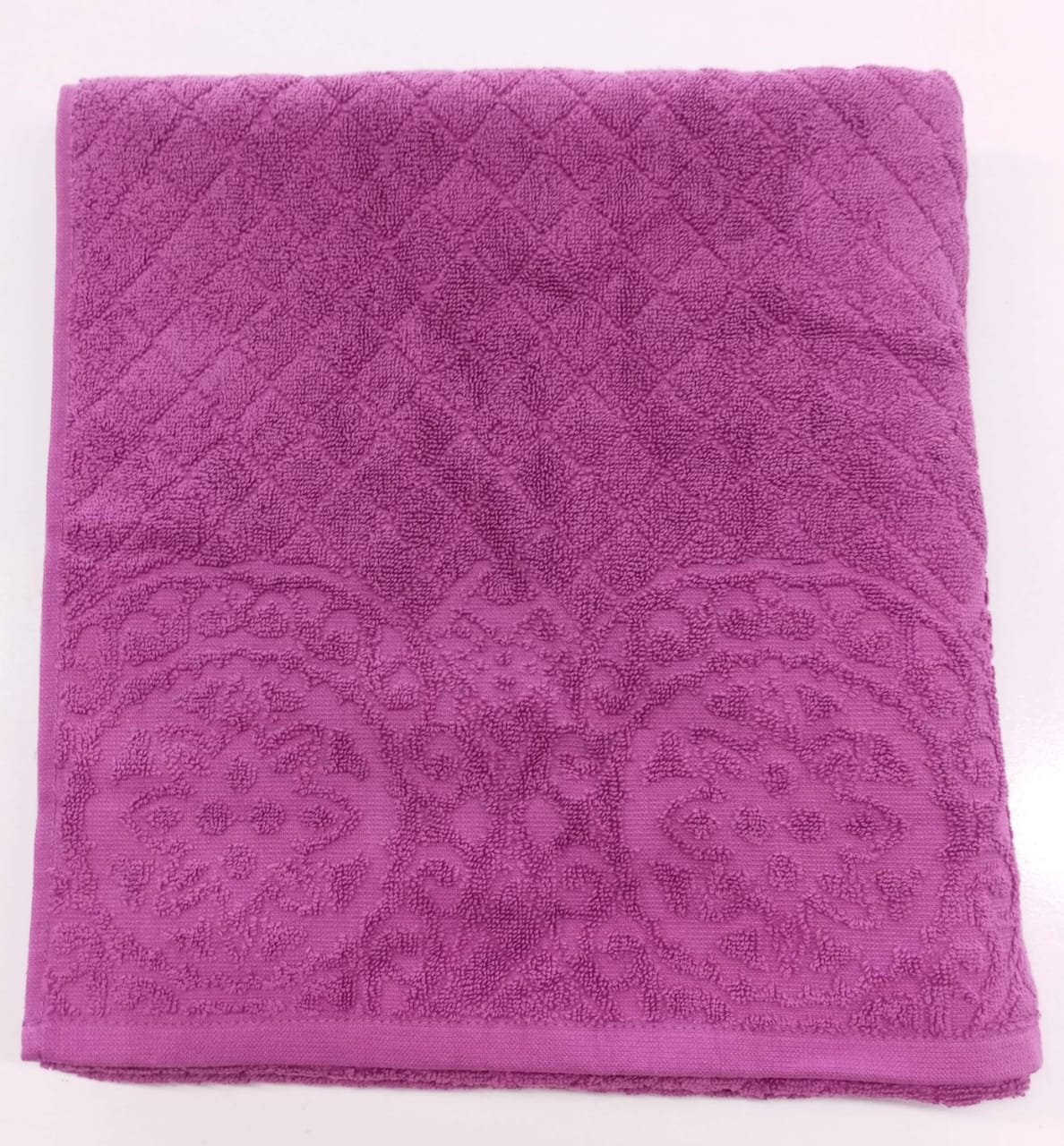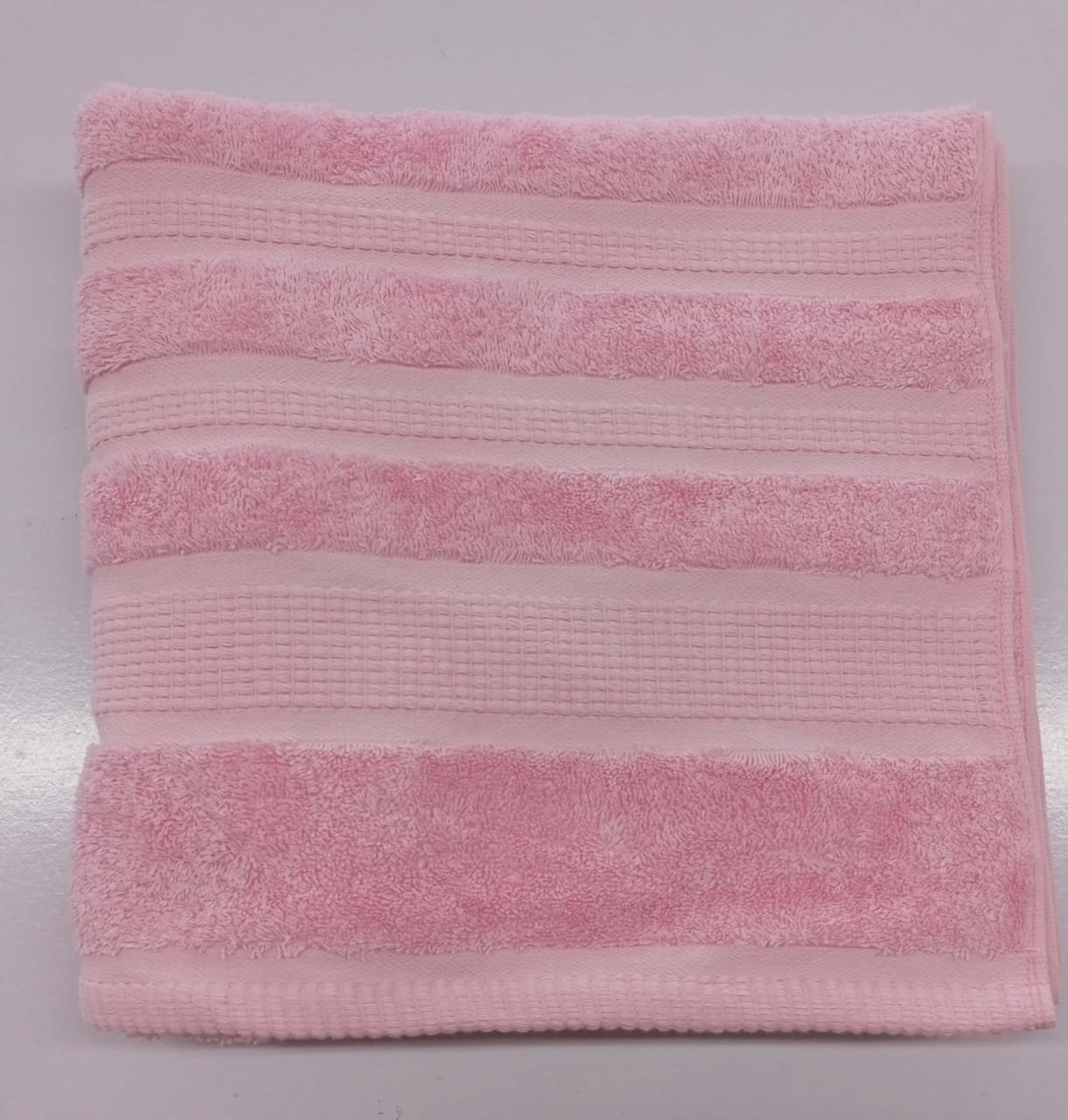
A terry cloth or terry towel is a fabric with raised, looped piles on its surface. These loops are created using a special pile beam during the weaving or knitting process. Terry towels can be made from various materials such as cotton, bamboo, Tencel, hemp, polyester, and microfiber. They can also be produced by blending different types of yarn to achieve specific characteristics.
Unlike simple woven fabrics that use only one warp beam for the warp yarns, terry towel fabrics use two warp beams. One is for the warp or ground yarn, and the other is for the pile yarn. This dual warp beam setup allows for the creation of pile loops on the surface of the towel.
Terry cloth can be produced using different looms, ranging from manual looms to more advanced air jets, water jets, and plasma jet looms. These modern looms are equipped with the latest technology, enabling higher production efficiency and accuracy.
1-Basic Parts of Terry's Towel:
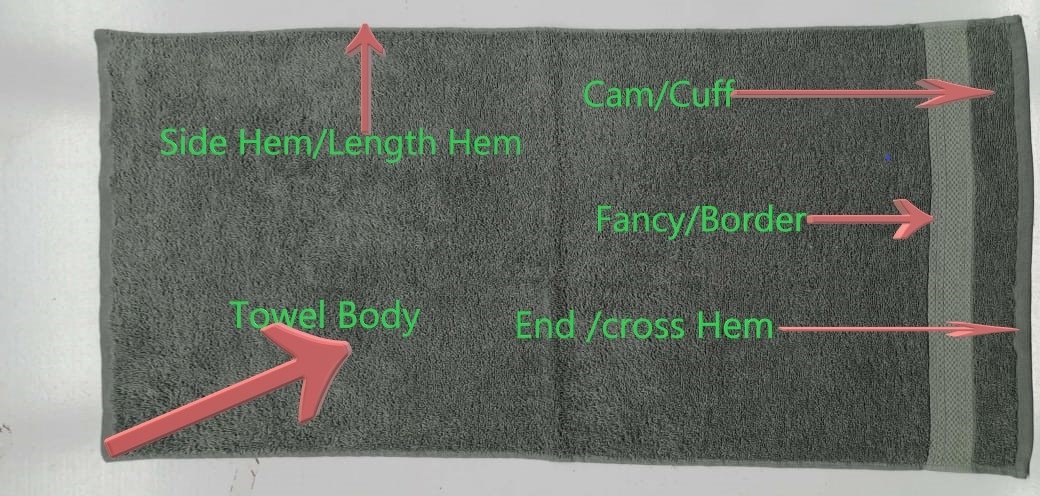
The basic parts of a terry towel include two cross hems at the top and bottom, two side hems on the left and right sides, a fancy border that can be on one or both sides of the towel, the cam or cuff which can also be on one or both sides and finally, the towel body. The towel body can have a one-sided terry or terry on both sides. The choice of using the same fiber on both sides with the same yarn count or using different fibers or yarn counts on each side depends on specific preferences or requirements.
2-Categorization of terry towel:
Terry towels are classified into four categories based on their end use, weaving mechanism, terry loop formation, and fibrous materials. Let’s discuss each of these categories to help you understand what is meant by end-use, weaving mechanism, terry loop formation, and fibrous materials.
1-Terry towel classification by end user.
Terry towels are designed for various purposes, each with specific dimensions and features. For drying the face, we have face towels measuring 13×13 inches. Hand towels, sized at 15×30 inches, are ideal for drying hands. Bath towels, larger at 27×54 inches, are perfect for drying off after a bath. Bath mat towels, measuring 20×40 inches, are used for drying the feet after bathing.
Beach towels or bath sheets, sized at 40×60 inches, are suitable for use at the beach or while sitting on the sand. Kitchen towels are used for wiping kitchen items. Bathrobes are used to keep warm after bathing, especially in snowy areas. Shower wraps and turbans are used by females to protect and keep dry their hair while after bathing. Lastly, terry slippers are used after bathing to keep the feet dry and warm, especially on carpeted floors where regular shoes cannot be used.
2-Terry towel classification by the pile loop formation.
The loop formation in terry towels is created using a beat-up mechanism on a terry towel loom, typically with the help of a pile beam. The most commonly used terry towels are made using a 3-pick terry method, which means that after every third weft yarn insertion, the beat-up is performed on the loom.
Alternatively, towels can also be made using 2-pick, 4-pick, 5-pick, 6-pick, or 7-pick terry methods. The strength of a towel made with 2-pick terry is relatively low, while a towel made with 7-pick terry is very strong. Despite this, the most popular and widely used method is 3-pick terry because it strikes a balance between production efficiency and towel strength, making it suitable for both users and manufacturers.
3-Terry towel classification by Cam Weaving Method.
Cam weaving is a method used in looms to control the raising and lowering of warp threads. It utilizes a series of cams, which are shaped discs, to achieve this. Cams are positioned on a camshaft and as the shaft rotates, the cams lift or lower the warp threads to create patterns in the fabric. Cam weaving is often used for simpler designs and patterns.
4-Terry towel classification by Dobby Weaving:
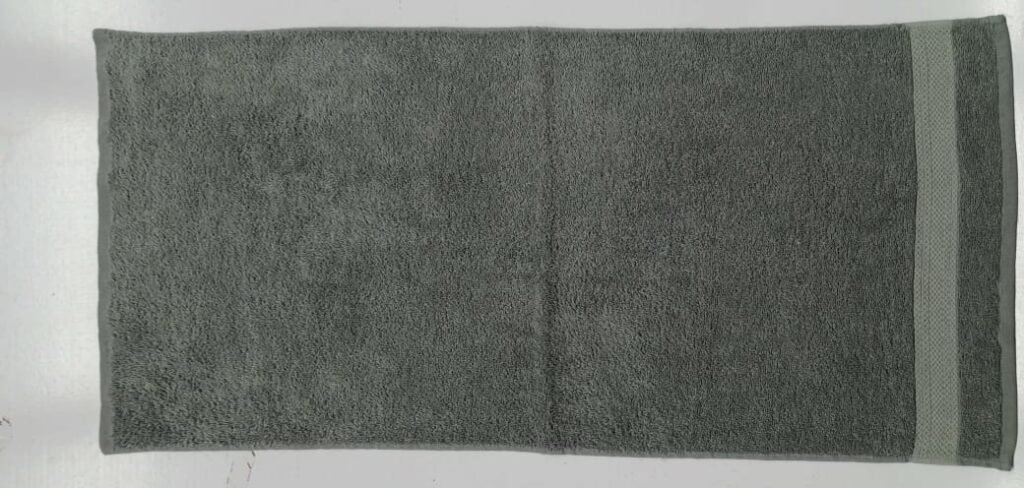
Dobby weaving is a more advanced weaving technique that uses a dobby mechanism to control the raising and lowering of warp threads. The dobby mechanism consists of small, individually controlled devices called dobby bars. Each dobby bar can be set to a specific position, allowing for more complex patterns and designs to be woven into the fabric. Dobby weaving is commonly used for creating intricate designs and patterns in fabrics.
Above picture is of the Dobby towel/fancy towel/border towel and is made from the Dobby loom.
5-Terry towel classification by Jacquard Weaving:
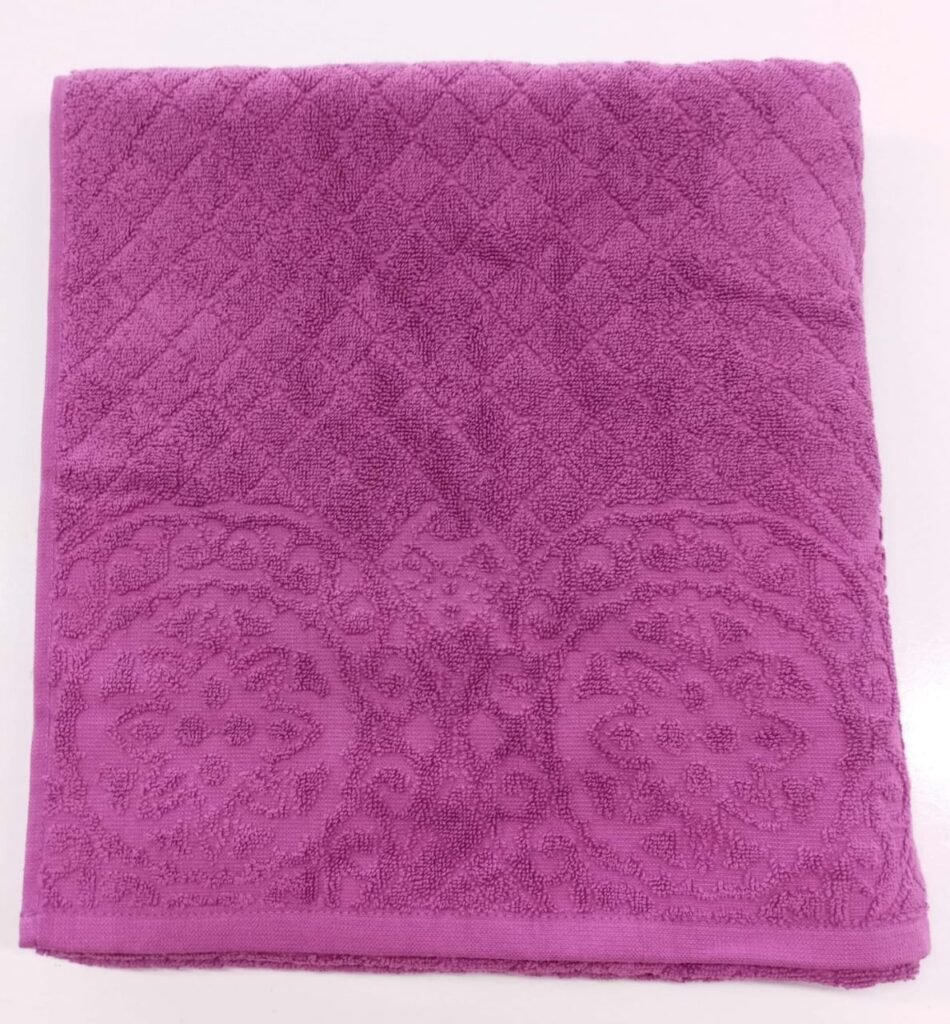
Jacquard weaving is the most complex of the three weaving techniques. It uses a jacquard machine to control each warp thread individually. The jacquard machine is equipped with a series of punched cards, each representing a row of the design. The presence or absence of holes in the cards determines whether a warp thread is lifted or lowered. Jacquard weaving allows for extremely intricate and detailed designs to be woven into the fabric, making it ideal for creating elaborate patterns and images.
In summary, cam weaving is the simplest method used for basic patterns, dobby weaving is more advanced and allows for more complex designs, and jacquard weaving is the most intricate and can create highly detailed patterns and images.
Above picture is the example of Jacquard towel and is made from the Jacquard weaving loom.
6-Terry towel classification by fibrous materials:
Towels made from different fibers have specific names based on the fiber used. For example, a towel made from cotton is called a 100% cotton towel, while one made from microfiber is called a microfiber towel. Similarly, a towel made from polyester is a 100% polyester towel, and one made from Tencel is a Tencel towel. A towel made from hemp fiber is a 100% hemp towel, and one made from bamboo fiber is a 100% bamboo towel.
Blending fibers results in towels with different properties. For instance, a blend of polyester and cotton creates a PC towel, and a blend of cotton and Tencel creates a cotton Tencel towel. Despite the variety, cotton towels remain the most popular due to their absorbency and durability. However, there is a growing interest in bamboo fiber towels for their softness and luster, as well as hemp blends for their natural antimicrobial properties. Nonetheless, cotton fiber towels continue to dominate the market.
3-Basic parameter of terry towel
1-Weight & GSM of terry towel:
The weight and GSM (grams per square meter) are crucial factors in determining the quality of a terry towel. GSM is particularly important as it indicates the density and weight of the towel. A higher GSM means a heavier towel, which often translates to a higher value. Heavier GSM towels are bulkier and tend to have better absorbency and a more luxurious feel.
2-Pile orientation of terry towel:
The orientation and height of the pile loops are crucial in determining the quality of a terry towel. Towels with more pile loops and higher pile height tend to absorb more water compared to those with fewer loops and lower pile height. Additionally, having a uniform pile orientation not only enhances the towel’s appearance but also improves its absorption properties, ensuring better performance with each use.
3-Dimensional stability of towel:
Dimensional stability is a crucial factor in terry towels because they undergo frequent washing, both in institutional and domestic settings. Good quality towels are those that have minimal shrinkage after washing, typically less than 5% in width and 7% in length.
4-Hand feel and softness:
Since terry towels come into direct contact with the skin, they must be soft with a good hand feel. To achieve this, they should be made from high-quality, soft natural materials. Additionally, a coarser yarn with a minimum twist per inch should be used. During the dyeing process, the towels should be finished with softening chemicals that can withstand multiple washes, ensuring that the softness is maintained over time.
5-Absorbency of terry towel:
The primary purpose of a terry towel is to absorb water, making absorbency a critical factor. A high-quality towel should instantly absorb water when droplets are placed on its surface. Good absorption is typically achieved within 7 seconds from the moment water is dropped onto the towel. Towels that take longer to absorb water are considered to have low absorbency and are likely made from lighter, less fibrous materials with a lower GSM (grams per square meter).
4-Frequently asked questions on the terry towel:
What are the different types of terry towels based on fiber?
Terry towels can be categorized based on the fiber used. For example, towels made from cotton are called 100% cotton towels, those made from microfiber are called microfiber towels, and so on.
How does the weight of a terry towel affect its quality?
The weight of a terry towel, measured in GSM (grams per square meter), is crucial. A higher GSM typically means a heavier towel, which is often associated with better quality and performance, including improved absorbency and a more luxurious feel.
What role do the pile orientation and height play in terry towels?
The orientation and height of pile loops are crucial in determining the quality of a terry towel. Towels with more pile loops and higher pile height tend to absorb more water and have a better appearance and absorption properties.
Why is dimensional stability important in terry towels?
Dimensional stability is crucial in terry towels because they undergo frequent washing. Good quality towels have minimal shrinkage after washing to maintain their original size and shape.
How does the choice of materials affect the softness of a terry towel?
The choice of materials greatly impacts the softness of a terry towel. Towels made from high-quality, soft natural fiber materials tend to be softer and have a better hand feel.
What role do finishing chemicals play in maintaining the softness of a terry towel?
Finishing chemicals are used during the dyeing process to add softness to terry towels. These chemicals help maintain the towel’s softness even after multiple washes, ensuring that it remains comfortable against the skin.

